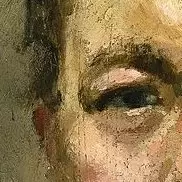C’est tres bon.
Monet’s life, especially during this time was a confusing mess. His wife had died a few years prior, his benefactor had gone bankrupt, and Monet had started communicating with his next wife all around the time of this painting, and many others similar to it. Therefore I have collected a few summaries from around the web about this:
Monet was inspired by Etretat in the Caux region of Normandy, which he visited every year between 1883 and 1886. He had first come across the area in 1868 and was particularly drawn by how picturesque it was - so much so that it resulted in more than 50 paintings. However, he only painted the Manneporte - the largest of three arches known as the “Gates,” twice. When this work was created in c. 1885, Monet regularly met with Guy de Maupassant, a popular 19th-century French writer - often considered one of the “fathers” of the modern short story. Etretat, where Maupassant was living at the time, was the selling chosen for a number of his own works. His thoughts and feelings were mirrored in the works created by Monet of these monumental cliffs and his love of the Normandy coast. Known as the “Elephant and the Needle,” due to the rock formations, these famous cliffs are painted by Monet in a typical Impressionist style, with its atmospheric conditions and the effect of the light. The illusion of movement on the sea is carefully created using separate brushstrokes, combined with vibrant colors. Monet was renowned for applying one color over another while the first was still wet - this is evident in this painting through the setting sun.
The work was painted during the winter months, presenting the artist with a number of obstacles, not least the weather, the difficult terrain, and the changing tides.
https://www.claude-monet.com/the-cliffs-at-etretat.jsp
Oscar Claude Monet is considered the archetypal Impressionist, with his devotion to painting the transient effects of light and color “en plein air” unwaveringly throughout his long career. Appropriately, it is one of his pictures, Impression: Sunrise, which gave the group of artists painting in this style its name. Born in Paris, Monet attended L’Academie Suisse from 1859-60 and subsequently enrolled in the studio of Glenyre, where he met Renoir and Sisley, with whom he formed the nucleus of the Impressionist group. He organized the first Impressionist exhibit in 1874 and became the group’s leader, initiator and unswerving advocate. Monet moved to Giverny in 1883, planting the extensive gardens and lily ponds that would provide the inspiration for his later works. From 1890 he concentrated on a series of pictures in which he painted the same subject at different times of the day in different light. The most popular of these are the Haystacks and Rouen Cathedral series. He continued to travel widely, visiting London and Venice several times, yet increasingly he focused his attention on Giverny. There, the celebrated water gardens inspired the Water Lilies series that dominated his work for the remainder of his life.
Cool!
Makes me think of the west wing
“Like a gym sock on a shower rod”
But this is actually a different painting of etretat.



